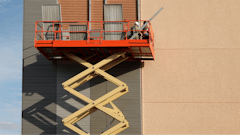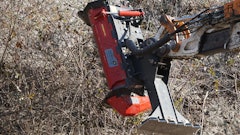On December 17, 2010, the California Air Resources Board (CARB) amended an earlier regulation to reduce diesel engine emissions in off-road vehicles. The original rule, adopted in July 2007, targeted both particulate matter (PM) and oxides of nitrogen (NOx). It called for equipment owners to disclose and label their diesel-powered equipment in preparation to meet new emission targets, the first of which was to kick in on March 2010. Nearly three years later, on February 11, less than a month before the first compliance dates were to be met, CARB issued a delay.
“The rule, which didn’t go into effect until 2008, was an effort by CARB to clean up existing products being operated within the state,” says engine consultant John Fischer. “In particular, diesel engines last a long time and current (older) ones would generate more pollutants than newer (Interim Tier 4 and finally ‘full’ Tier 4) ones. The original rule promoted the retrofitting of emissions reduction devices as well as turning over of the fleet, what CARB refers to a ‘fleet modernization.’
“Fitting with a Diesel Particulate Filter (DPF) can be done on older engines to reduce particulates. NOx reduction, however, is not easily retrofitted, but can be accomplished by trading up to a new machine with an engine that generates lower levels of NOx.”
The actual compliance date depended on the size of the diesel-powered fleet. The March 2010 date applied to CARB’s definition of large fleets, those with a total fleet horsepower in excess of 5,000. Contractors and rental companies with a total fleet horsepower of 2,501 to 5,000 had until the beginning of 2013 and smaller operators had until 2015 to meet new emission standards. Similar rules applied to diesel-powered on-road vehicles and portable power equipment.
Caught off guard
Large and medium fleets were required to meet both new PM and NOx targets whereas smaller operators were required to meet PM targets only. CARB gave this rationale for the less stringent, small-fleet requirements, including the later compliance date: Small fleet operators would likely find understanding and financing the new regulations more difficult than their bigger counterparts, and their large number (contractors with only a few pieces of equipment) would create enforcement challenges early on.
Again, rental companies with large diesel off-road fleets originally had until March 2010 to meet compliance PM and NOx target rates. As Fischer pointed out, they could do that in any of several different ways by applying exhaust retrofits; repowering equipment with new engines or rebuilding the old engines; and accelerating fleet turnover.
“The rule caught us completely off guard,” relates Tyler Hardy, general manager of product support for Livermore, California-based Cresco Equipment Rentals. “Up to that point, meeting emissions standards had been the responsibility of OEM’s, The new rule changed that, and gave all of us in the rental business something new to think about.”
Indeed, with 19 store locations and an off-road diesel fleet average well over 100,000-hp, Cresco had its share of homework to do, starting with meeting the reporting, labeling, and disclosure rule requirements. “We had to get data on and track every piece of diesel equipment in our fleet,” recalls Hardy. “We hired an individual to do just that, a job that took up probably 60 percent of his time.”
In addition to recording engine serial numbers and emission families on spread sheets, for most of its diesel-powered off-road equipment the company had to document equipment and submit relevant information to CARB’s Web Site In return, equipment was issued an EIN number and decal to be placed on the left side of the equipment. Diesel-powered portable equipment and on-road equipment also had to be recorded and tracked.
By March 1, 2010, the fleet not only had to be in compliance with performance requirements, the actions taken to meet these requirements had to be reported to CARB no later than April, 2010. “Once we had collected all the data, we realized we weren’t in bad shape for meeting the March 2010 date,” says Hardy. “Our off-road fleet consisted primarily of equipment powered by Tier II and Tier III engines. If I recall, we may have sold a couple of pieces of older equipment to help ensure compliance.”
As he points out, to be competitive, most rental companies need to have newer equipment in their fleet, not to mention the fact that 75 percent of Cresco’s contractor customers work in the Bay Area where strict emission standards on federally funded projects already were in place. Adds, Hardy, “The rule may have caught us off guard, but I believe, too, that doing the right thing will help in the long run.”
Clean fleet
According to ARA Vice-President of Government Affairs John McClelland, Cresco’s moves to meet the original compliance time of March 2010 mirrored those of other large and medium-sized rental companies. “We haven’t had a great number of complaints from our members about the rule,” he relates. “What seemed to be the biggest immediate challenge was understanding how to use CARB’s DOORS web site, and we guided several members through that exercise.
He notes that long term there were issues. “We made it clear to CARB that using their compliance model and using the rental fleet data we had that a rental company with a very clean fleet could have been unable to comply with the rule as implemented and forced to needlessly eliminate certain pieces of equipment from the fleet before normal attrition. In terms of meeting the original rule, we know that rental companies have the cleanest fleets in California. Yet some would have their hands tied because the poor economy in California has forced rental fleet operators to buy less new equipment and extend the use of their remaining fleet.”
As McClelland points out, regulations come with compliance costs and there has to be a compelling reason for a regulation, and it has to be based on sound science, something the original rule lacked. “Our analysis was that the fuel use figures ARB estimated from their emissions inventory model were four times greater than what we could verify using independent data sets, including data from the U.S. Energy Information Agency.
In a statement last April, CARB attributed a down economy to the lower inventory numbers. Said ARB’s chairperson Mary Nichols, “We fully recognize that the economy has had an effect on the owners and operators of big rigs, buses, and construction equipment. We are committed to taking those impacts into consideration for our diesel clean-up program.”
Because of the economy, compliance costs was another concern and, as Fischer notes, CARB sometimes anticipates a need assuming the market will respond in kind when in fact the cost of testing and producing a fix (e.g., a filter) may not be financially worthwhile Not to say this attributed to the rule changes, but collecting PM on off-road diesel equipment can be cumbersome anyway, he adds. “These filters can be very large and depending on the equipment and application, they can impede an operator’s view.”
New rules
Working with ARA, the Associated General Contractors (AGC), and the off-road implementation advisory group CARB set about changing the proposed rules for off-road equipment (as well as on –road and portable power equipment). As mentioned above, the new rule was finalized on December 17, 2010. The off-road changes would:
- Delay start of requirements until January 1, 2014
- Increase the number of “low-use” equipment exempted
- Provide simpler compliance options for the smallest fleets
- Extend benefits for businesses that comply before their deadline
- Lower annual requirements to clean up engines
The changes also addressed a concern raised by Cresco’s Hardy about rewarding rental companies that had been proactive in meeting original target emission guidelines. In addition to streamlining the compliance process and offering additional time and flexible options to meet requirements, CARB indicated the rule changes would provide credits for efforts already made to reduce emissions.
“The PM and NOx levels are more in line with reality now, says McClelland about the new rule for off-road equipment, “and it slides compliance a couple of years forward. The way it treats PM is not nearly as stringent either. ARA also specifically proposed and supported averaging provisions so rental operations wouldn’t be forced to change the way they do business because the rental business model in the U.S. is based on renting the newest, cleanest equipment in the market.”
Smaller companies and smaller operators with a couple of older pieces of equipment will likely be challenged most by the rule, although a few of the changes, specifically an increase in exemption number for “low-use” equipment and simpler compliance options will help. As he points out, “The rule isn’t perfect, but it now has a more realistic grasp of emissions’ inventory.”


























